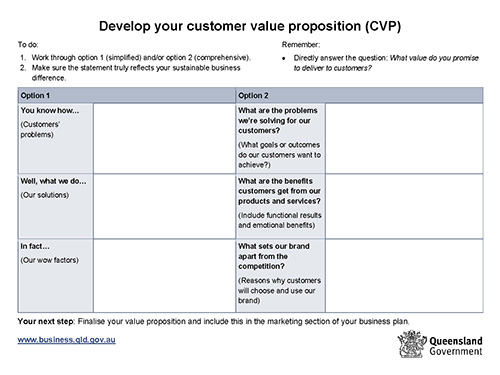Identifying your competitive advantage and value proposition
To stay ahead, you must be able to show the unique value your business offers. Understanding your customers and your competitors can help you develop your value proposition.
On this page
Find your competitive advantage in 3 steps
Your competitive advantage is the combination of marketing elements that sets your business apart. It’s about the unique benefit customers get when they do business with you. Practical examples include:
- free home delivery
- a money-back guarantee
- personalised service.
Finding your competitive advantage will help you to make the most of your existing strengths and to prioritise improvements. A strong competitive advantage will:
- highlight customer benefits
- reflect your business strengths
- be clear, simple and unique
- change over time to adapt to new conditions.
The following 3 steps can help you find your competitive advantage.
Clarify your customer value proposition (CVP)
Your marketing programs will be more focused and effective when you:
- know what your competitive advantage is
- have a unique and relevant brand positioning.
Improve this further by being clear about your customer value proposition (CVP).

Customer value proposition template
Develop your customer value proposition (CVP) by:
- reading the information above
- searching online for ‘customer value proposition examples’
- using the template to write your CVP.
Create unique selling points (USPs)
Based on your competitive advantage, you’ll have one or more unique selling points (USPs).
Meet your legal obligations
While competition may be fierce, it’s important to still follow fair and legal practices. Every business must comply with the relevant laws while trying to find a position in the market.
The most important legislation to be aware of is the Competition and Consumer Act 2010. It provides a fair and competitive operating environment and covers:
- contract law and unfair contract terms
- consumer rights when buying goods and services
- product safety
- unsolicited consumer agreements, including door-to-door and telephone sales
- penalties, enforcement powers and the rights of consumers to seek compensation.
To understand your rights and responsibilities in the field of competition law, you can read:
- Australian Consumer Law guidance – advice on how to comply with the Competition and Consumer Act 2010
- Office of Fair Trading sales practice guidance – advice on making your sales practices are fair and legal.
Maintain your relevance
The only constant in business is change. That’s why it’s important to regularly review the trends that are shaping your market. These could include things like new:
- behaviours
- technologies
- competitors
- solutions.
You may need to evolve your business, but change also creates opportunities. This will require change management. Find out more about how to adapt and change your business.
The marketing field is always changing too. There’s often an overemphasis on ‘shiny new things.’ It’s good to stay up to date, but always:
- refer to the fundamentals of marketing
- adopt a strategic approach.
Your goal is to achieve your marketing objectives. To support this journey, make sure you refer to industry sources and external partners for:
- resources
- training
- advice.
Visit the Australian Marketing Institute to find information on best practice and standards.
Also consider…
- Find help to write a marketing strategy and plan.
- Learn more about branding your business.
- Find information on how to become a customer-focused business.
- Access tips and calculators to help you successfully price products and services.
- Find out more about writing a business capability statement.
